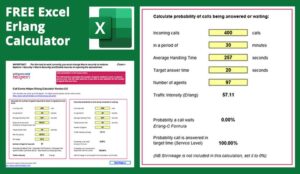When managing a contact centre, especially within Workforce Management (WFM) and Business Process Outsourcing (BPO), you’ll often come across the terms occupancy and utilisation.
At first glance, they may seem interchangeable, but in reality, they measure two distinct aspects of agent productivity and operational efficiency.
Understanding the difference between these metrics is crucial for optimising staffing levels, improving agent performance, and ensuring a smooth customer experience. While both relate to how agents spend their time, they focus on different perspectives.
In this article, we’ll break down what each term means, how they’re calculated, and highlight the value of calculating both in the contact centre.
Occupancy vs Utilisation
What Is Occupancy?
Occupancy is calculated as a percentage and represents the amount of time that advisors spend on call-related activity while they are logged in and expected to be taking calls. “Call-related activity” includes talk time, hold time and wrap time. It is often referred to as “productive time”.
“Occupancy answers the question: for what percentage of the time that my advisors are logged in live are they actually busy with a customer activity, or are they available to do more?” – Henriette Potgieter
It is typical for a contact centre’s occupancy to lie between 80 and 85%, and if your occupancy rate is at this level, it is likely that your Resource Planning team are doing a good job. However, if occupancy is consistently higher than 85%, you are risking advisor burnout.
But remember, there is no recommended best-practice benchmark for occupancy, and targets should be set with a goal of continuous improvement in mind, balancing financial/budget requirements with employee needs.
The Occupancy Formula
Here are the two equations that most contact centres use to calculate occupancy.

This formula works out occupancy by dividing ‘Total Contact Handling Time’ by ‘Total Logged Time’, and then multiplying this by 100 to get the percentage.
Occupancy (%) = (Total Contact Handling Time ÷ Total Logged Time) x100
However, these formulas are often presented using the following terminology, although they all equate to the same thing:

Which calculates occupancy by dividing the ‘Traffic Intensity (Erlangs)’ by ‘Raw Advisors’, and then multiplying this by 100 to get the percentage.
Occupancy (%) = (Total Intensity (Erlangs) ÷ Raw Advisors) x100
For more on how to use the occupancy formulas in practice, read our article: How to Calculate Occupancy
What Is Utilisation?
Like occupancy, utilisation is calculated as a percentage. However, it differs from occupancy as utilisation instead represents the amount of time that advisors spend logged-in, handling and expecting contacts, while present in the contact centre.
“Utilisation answers the question: for what percentage of the time that I pay my advisors are they logged in and assisting or available to assist with a customer activity?”– Henriette Potgieter
So, utilisation calculations include all the time spent on internal shrinkage activities, not just logged-in time.
These internal shrinkage activities include:
- Coaching and training sessions
- Team meetings
- One-to-one reviews/chats
- Toilet and other unplanned facility breaks
- Time spent helping other departments
- Special and creative projects
- System downtime
The Utilisation Formula
Put simply, utilisation calculations include the total shift time of an advisor, not just the logged-in time when they are available to take contacts.
This is evident in the utilisation formula below.

To calculate utilisation using this formula you divide ‘Total Logged-In Time’ by ‘Total Shift Time’ and then multiply this by 100 to get the percentage.
Utilisation (%) = (Total Logged-in Time ÷ Total Shift Time) x100
Just be careful to remember that while all internal shrinkage activities are part of the “total shift time”, time taken for external shrinkage activities should not be included. This includes things like paid breaks, absence and lateness.
For more on how to use the utilisation formula in practice, read our article: How to Calculate Call Centre Agent Utilisation – the Formula
What is the Difference Between Occupancy and Utilisation
To summarise, while occupancy and utilisation are both key workforce metrics, they serve different purposes in measuring agent activity and efficiency:
Henriette Potgieter, a call centre best practice management consultant at QBIC Solutions, tells us: “Occupancy differs from utilisation in that occupancy considers only live logged-in time, but utilisation considers total time at work (including logged-out time such as training).”
- Occupancy: The percentage of time advisors spend on call-related activities while logged in and available to take calls.
- Utilisation: The percentage of total shift time that advisors are logged in, including time spent on internal shrinkage activities like training and meetings.
Why Is It Important to Measure Occupancy?
“Occupancy is especially important in schedule design, as it assists with measuring schedule optimisation, so as not to have advisors sitting and waiting for calls too often.” – Henriette
Occupancy rates are a great indicator of the efficiency of your staffing calculations. But not only that, the occupancy metric is a key part of scheduling advisors, if you do so with the Erlang Calculator and not workforce management (WFM) software.
In fact, top-of-the range Erlang Calculators will include an occupancy target. So, enter in your preferred occupancy rate (between 80 and 85%) and the calculator will give the ideal number of advisors to match that percentage, which will also be based on the other information that you’ve provided. This other information will include contact volumes, Average Handling Time (AHT) and so on.
However, occupancy must only be measured on a contact centre-wide level; it cannot be used as an advisor target. Advisors cannot control when they receive calls and shouldn’t be pressured by handling times, so it’s a measure for the Resource Planning team only and not a measure of advisor productivity.
Why Is It Important to Measure Utilisation?
“Utilisation is important as input to overhead cost or shrinkage calculations, as it considers ‘non-customer-related activities’ that still get paid for, but that take the advisor away from servicing a customer.” – Henriette
Overhead costs are business expenses that help to build the success of your business but do not directly generate any revenue. Utilisation is therefore a consideration for overhead calculations.
Also, as Henriette referenced, utilisation rates can be useful in calculating overall shrinkage, as they provide an idea of total hours of internal shrinkage. This is important when considering the equation for overall contact centre shrinkage.
The Shrinkage Formula
The formula to calculate shrinkage is as follows:

This formula calculates shrinkage by adding the ‘Total Hours of External Shrinkage’ to the ‘Total Hours of Internal Shrinkage’, then dividing this by the ‘Total Hours Available’, before multiplying this by 100 to get a percentage.
Shrinkage (%) = ((Total Hours of External Shrinkage + Total Hours of Internal Shrinkage) ÷ Total Hours Available) x 100
For more on measuring shrinkage and how to use this formula in practice, read our article: How to Calculate Shrinkage
Other Metrics Not to Be Confused With Occupancy and Utilisation
While occupancy and utilisation are often confused, both metrics also have similarities to others that are commonly used in the contact centre.
So, let’s quickly introduce you to these so-called “others”, to see how they differ.
Schedule Adherence
Schedule adherence is the percentage of the advisor’s scheduled working day when they are present at work. This includes all internal shrinkage activities.
For further clarification, here’s an equation for contact centre adherence:

The formula to calculate schedule adherence divides the ‘Minutes in Adherence’ by the ‘Total Scheduled Minutes’, then multiplies this by 100 to get a percentage.
Schedule Adherence (%) = (Minutes in Adherence ÷ Total Scheduled Minutes) x100
So, if an advisor was supposed to work from 8am to 9am, but instead worked from 8.05am to 9.05am, their schedule adherence rate was 91.6%.
This is because they were present for 55 of their scheduled 60 minutes. The additional five minutes they worked was “out of adherence”.
To find out more on measuring schedule adherence, read our article: How to Calculate Schedule Adherence
For mote information on calculating schedule adherence, read our article: How do I Calculate… Schedule Adherence?
Conformance
Conformance is a percentage measure of the amount of time that an advisor spends at work, versus the amount of time that they were scheduled to work.
The formula for conformance looks like this:

This formula calculated conformance by dividing the ‘Actual Work Time’ by ‘Scheduled Work Time’, then multiplies the result by 100 to get a percentage.
Conformance (%) = (Actual Work Time ÷ Scheduled Work Time) x100
So, using the example above, if an advisor was supposed to work from 8am to 9am, but instead worked from 8.05am to 9.05am, their conformance rate was 100%. This is because they were present at work for the exact same number of minutes they were supposed to be.
It is especially important to consider adherence and not just conformance, as adherence looks at whether you are supporting the business when you should be, at the right times.
If you are looking for more advice on using conformance in the contact centre, read our article: How to Calculate Conformance
Productivity
While this isn’t exactly an individual metric, many people use occupancy as an indicator of productivity. But, as highlighted earlier, occupancy is a WFM metric only and shouldn’t be used at an advisor level.
Productivity calculations should be mostly made up of schedule adherence, because that is something that advisors have complete control over.
Just remember that the contact centre is not a factory, which means that advisor productivity should not be measured through efficiency metrics.
To find out more on measuring productivity, read our article: How to Calculate Productivity
For more on contact centre metrics, read our articles:
- What Are the Industry Standards for Call Centre Metrics?
- The Top 10 Most Important Call Centre Metrics
- Contact Centre Metrics: Are You Measuring the Right Things?
Author: Charlie Mitchell
Reviewed by: Hannah Swankie
Published On: 22nd Oct 2018 - Last modified: 13th Aug 2025
Read more about - Workforce Planning, Adherence, Henriette Potgieter, Key Performance Indicators (KPIs), Metrics, Occupancy, Shrinkage, Utilisation, Workforce Planning








































